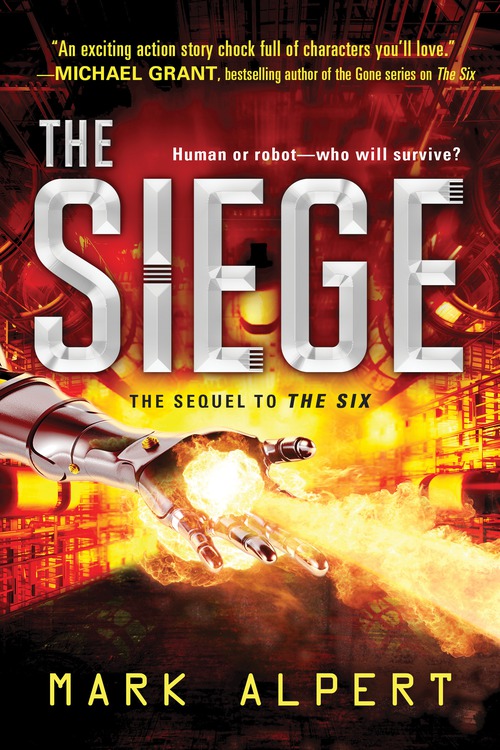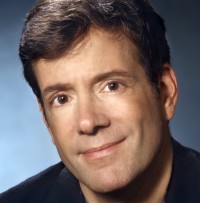The Siege by Mark Alpert
Alpert Makes Science Thrilling for Young Adults
 By Sonja Stone
By Sonja Stone
Mark Alpert—astrophysicist-turned-author—sold his first work of fiction, a short story, several decades ago to Playboy magazine. The Big Thrill caught up with Alpert to talk about his research, the writing life, and his second young adult thriller, THE SEIGE, sequel to The Six, which releases this month.
The Six tells the story of six dying teenagers, called the Pioneers, whose lives are “saved” when their minds are downloaded into army robots. In THE SEIGE, the Pioneers discover a new enemy—an artificial-intelligence program named Sigma. And Sigma has an ally: one of the Pioneers is a traitor.
You’re on your second YA novel. What would you say are the key differences between writing adult vs. young adult? What advice would you give other thriller writers who want to write for young adults?
The adolescent brain is different from the adult brain. Adolescent brain cells are more flexible (but less efficient) than adult neurons, and there are more connections among them. So it’s natural that teenagers think differently. Their brains are geared for seeking novelty and thrills, and at the same time they have poor impulse control. They feel everything more intensely, both the good and the bad. (I read somewhere that ice cream will never taste as good as it did when you were a teenager.)
I picked up all these neuroscience tidbits because my young adult novels are about teenagers who transfer the contents of their minds to robots, so I had to learn a little about teenage brains. To write a YA novel, you have to show the extremes that your adolescent characters are going through, the crushing disappointments and the dizzying joys. In other words, you have to remember what it’s like to be a teenager.
In addition to your impressive collection of novels, you’re a contributing editor at Scientific American. The Six and THE SIEGE are obviously well-researched and full of accurate scientific possibilities. Is it tricky to find the balance between science and fiction—especially for the young adult audience?
I think novels about science are most enjoyable when you emphasize the awesomeness and don’t get bogged down in the details. The Six and THE SIEGE are about the Singularity, the hypothesized turning point in the near future when machines will leap past humans in all endeavors. Artificial intelligence programs will start making important decisions without any human input and eventually become self-improving and self-aware. Robots will master all skills and become commonplace. And people will start incorporating machines into their bodies to enhance their health and mental abilities. At some point, it may become possible for people to achieve immortality by scanning their brains with such precision that everything is recorded—their memories, their emotions, their virtues, their flaws. Then all that information can transferred to neuromorphic circuits—a real technology that I learned about during a visit to an IBM research lab—that are designed to mimic the functioning of brain cells. The circuits can then generate new thoughts and emotions. The person will “wake up” inside the machine.
So the transformation that my teenage characters undergo in my novel—from terminally ill humans to superhuman robots—may someday be an option for everyone. That’s why I call them Pioneers.
The key to presenting this science in a YA novel is to make it part of the drama. Show the teenager being strapped to the scanning table as his body is dying. Then show him waking up inside an eight-hundred-pound robot. Show him struggling to breathe when he no longer has any lungs. Show the terror and wonder.
I’m always interested in other authors’ writing routines. I know you like to write late at night; do you write every day? Do you have a word count you try to reach? And what do you do on those beautiful summer nights when you’d rather be outside?
I work under deadline, so I need to follow a schedule. For instance, I have to finish an 80,000-word YA novel by the middle of August, so that means I need to write about a thousand words every weekday from now until then. A thousand words doesn’t sound like a lot for a full day’s work, but I revise everything I write until I’m happy with it, and that slows things down. Sometimes I don’t hit my word count until late at night, and sometimes I have to skip fun events during the day. But I don’t mind the sacrifices if the work is going well.
In THE SIEGE, one of the Pioneers is a traitor, assisting Sigma, the artificial intelligence that seeks to destroy them. Did you know when you started The Six that one of the Pioneers would turn? Had you already selected the traitor?
I didn’t come up with the betrayal idea until I finished the first draft of The Six, and I didn’t decide who the traitor would be until I started writing the outline of THE SIEGE. At the end of The Six, the artificial intelligence known as Sigma establishes radio contact with one of the Pioneers, who collaborates with the AI by informing on his fellow robots. In the text I refer to the traitor as Pioneer X; that’s the cliffhanger for the first book in the series. When my 14-year-old daughter finished that book, the first thing she asked me was, “Who is Pioneer X?” I replied, “I can’t tell you. That would spoil the surprise.” She said, “Come on, I’m your daughter, you have to tell me.” But I stood firm and said, “No, you’ll have to read THE SIEGE like everyone else to find out.”
THE SIEGE features Adam, Zia, Shannon, Marshall, and DeShawn. Aside from the protagonist, Adam, which of the characters is your favorite, and why?
My favorite is Zia. In THE SIEGE, her mind occupies a machine called the War-bot, which is the biggest and baddest of the Pioneer robots. It’s nine feet tall and three feet wide. Its steel arms are as thick as telephone poles and they’re bristling with rocket launchers and other weapons. The machine fits her personality, because Zia is insanely aggressive. Before her human body died, she belonged to a street gang in Los Angeles. After her soul becomes software, she bullies the other robots and takes a particular dislike to my hero, Adam Armstrong. Later on, though, Adam catches a glimpse of some of the memories stored in Zia’s circuits and he discovers why she’s so angry at the world. As he notes in The Six, “Only a horrendously wounded person could feel such rage.”
*****
 Mark Alpert, a contributing editor at Scientific American, writes thrillers that weave real science and technologies into the story. His first novel, Final Theory (Touchstone/Simon & Schuster, 2008), was published in 23 languages and became an international bestseller. His next science thrillers were The Omega Theory (Touchstone, 2011), Extinction (Thomas Dunne Books/St. Martin’s Press, 2013) and The Furies (Thomas Dunne, 2014). His latest novel, The Orion Plan (February 2016), is about an alien invasion of New York City. His first Young Adult novel, The Six, was published in 2015, and its sequel, THE SEIGE, will come out in July 2016. Mark lives with his wife and two teenage kids in New York. He’s a proud member of Scientific American’s softball team, The Big Bangers.
Mark Alpert, a contributing editor at Scientific American, writes thrillers that weave real science and technologies into the story. His first novel, Final Theory (Touchstone/Simon & Schuster, 2008), was published in 23 languages and became an international bestseller. His next science thrillers were The Omega Theory (Touchstone, 2011), Extinction (Thomas Dunne Books/St. Martin’s Press, 2013) and The Furies (Thomas Dunne, 2014). His latest novel, The Orion Plan (February 2016), is about an alien invasion of New York City. His first Young Adult novel, The Six, was published in 2015, and its sequel, THE SEIGE, will come out in July 2016. Mark lives with his wife and two teenage kids in New York. He’s a proud member of Scientific American’s softball team, The Big Bangers.
To learn more about Mark, please visit his website.
*****
About the author: Sonja Stone
Sonja Stone collected intel on psychology and creative writing from Washington College, trained at Le Cordon Bleu for a cover job as head pastry chef, and completed a handful of courses at the same survival school where Tom Hanks prepared for Cast Away. Currently, she’s raising two covert agents masquerading as typical teenagers. Just to be safe, Sonja’s learned to throw knives, fire guns, and navigate the desert, because…well, you never know. She’s currently writing the sequel to her debut YA thriller, DESERT DARK, and blogging with seven other thriller authors at RogueWomenWriters. Twitter @sonjastone1.
- THE GOD IN THE SEA with Paul Kemprecos - April 4, 2024
- FOR WORSE with L. K. Bowen - April 4, 2024
- HIT AND RUN with Vincent Zandri - April 4, 2024
